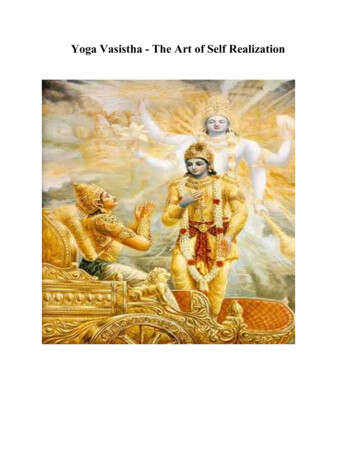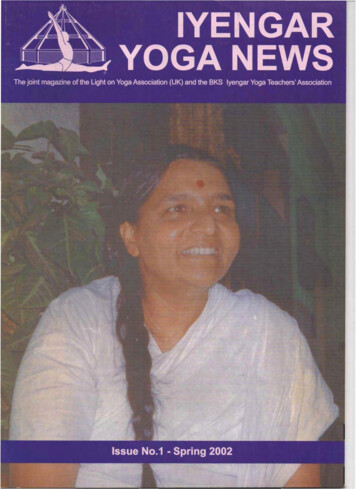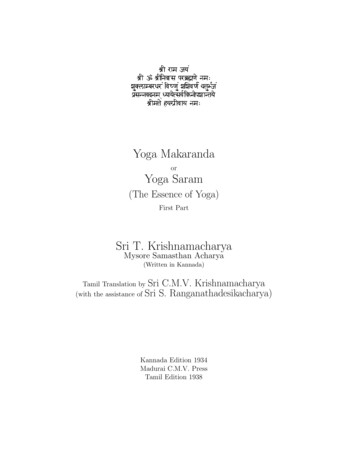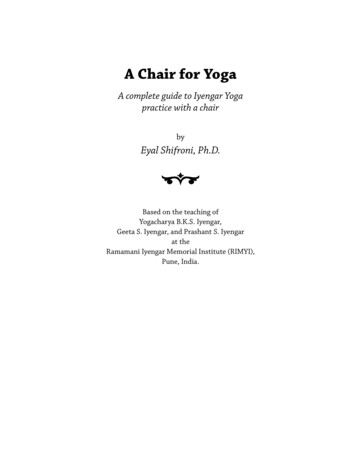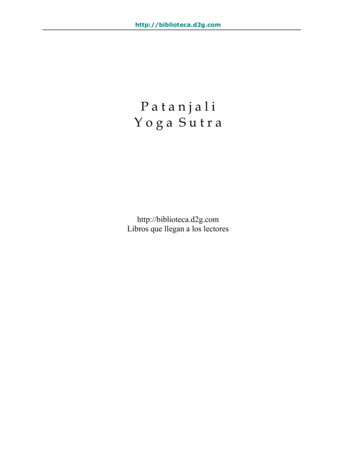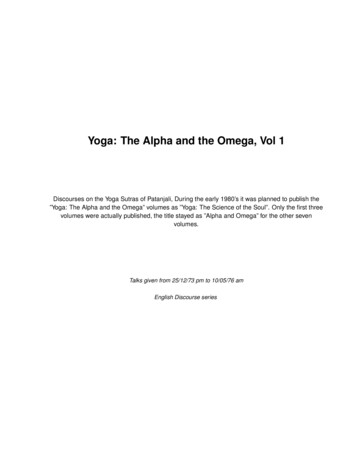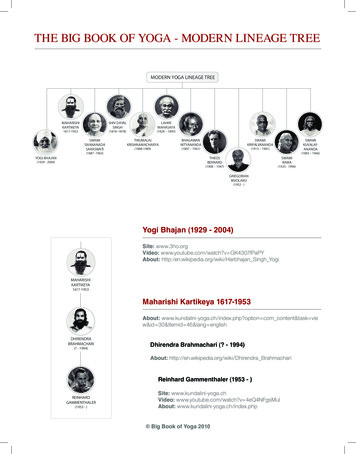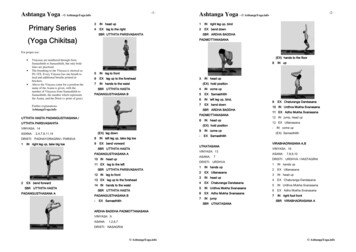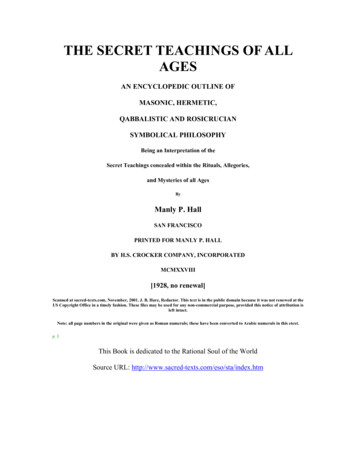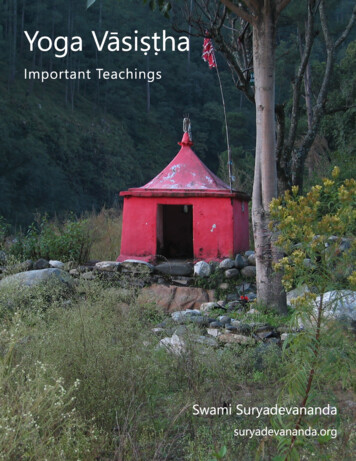
Transcription
YOGA VĀSIṢṬHAImportant TeachingsSwami Suryadevanandasuryadevananda.org2016FOR FREE DISTRIBUTION AND PERSONAL USE ONLY
DEDICATED TOG ur u dev S w a m i S i v a na n daAndS w a mi V en ka te s a n a n daYoga Vāsiṣṭha, Important Teachings2
PREFACEThis offering was not intended to be a book as such. I kept somenotes on the main points covered in the video and expandedthem a little so there could be a take-home in the form of a pdfhandout to be released along with each video. I have receivedsome feedback on culling these handouts into an eBook so witha little tweaking—here it is. I humbly offer this unto all who mayfeel it useful.The Yoga Vāsiṣṭha is a very important scripture for sincereseekers of the truth but perhaps not as well-known as someothers. This scripture has many stories that are used to point to subtle truths which are generallyhard to absorb theoretically—especially today, when political correctness imposes itself on directcommunication. Swami Venkatesananda’s translations on the Yoga Vāsiṣṭha are the very best asonly excessive descriptions in the story or redundancy is left out but the essentials are broughtto light in very simple language.Here, I have chosen to focus on the important teachings communicated through the stories,without the stories or illustrations. This has its advantages and disadvantages. The reader maynot get the background based on which or through which the teachings were communicated andit may also seem repetitive as some stories bring out teachings covered earlier so some overlapand redundancy was unavoidable. The advantage however falls to seekers who have been on thepath for a while and are able to grasp the subtle but lofty truths without concern of redundancy.Chapter six is the largest part of the scripture and broken in two parts. I have gone light in thecontents of this chapter and instead, chosen to focus on topics useful to the seeker which ismostly in the earlier chapters. I recommend a study of either version of Swami Venkatesananda’swork, the fuller version or the concise version to benefit from this focused attempt to highlightthe main teachings of the Yoga Vāsiṣṭha. Let us begin.Swami SuryadevanandaOctober 2016Website: suryadevananda.orgFOR FRE E DISTRIBUTION AND PERSONAL USE ONLYYoga Vāsiṣṭha, Important Teachings3
CONTENTSPRAYER BEFORE STUDY9Part 1 (Chapter I)10Introduction10Part 2 (Chapter II begins)121. The liberated sage122. Self-effort123. Essence of all scriptures124. The course of action12Part 3 (Chapter II continues)13FOUR GATEKEEPERS TO THE REALM OF FREEDOM OR MOKṢA131. Śama or self-control132. Vicārana or the spirit of inquiry133. Santoṣa or contentment134. Satsaṅga or good company13Part 4 (Chapter II ends)151. The task152. In the heart first153. Self-control next154. Then inquiry16Part 5 (Chapter III begins)171. The illusion172. The cure173. Spiritual discipline174. All these help18Part 6 (Chapter III continues)191. Beyond conditioning193. Staying undistracted204. Beyond restlessness20Yoga Vāsiṣṭha, Important Teachings4
Part 7 (Chapter III continues)221. Restlessness222. Controlling the mind233. Understanding renunciation23Part 8 (Chapter III continues)251. How bondage happens252. Mind is the doer253. Liberation and delusion264. The unconditioned state26Part 9 (Chapter III continues)SEVEN STATES OR PLANES OF WISDOM27271. Śubhecchā or a noble wish292. Vicāraṇā or direct and steady observation of the mind293. Tanumānasi or the thinned and weakened mind294. Satvāpatti or natural turning away from sense pleasure and dwelling in truth295. Asamśaktti or natural and total non-attachment or freedom306. Padārthābhavanī or natural cessation of objectivity307. Turīya or liberated while living30Part 10 (Chapter III ends)311. Yoga—the way of purification312. Appearances—reflections in consciousness313. Reality—the indivisible consciousness32Part 11 (Chapter IV begins)Simple Ways to Increase Satva or Natural Goodness34341. Do not grieve or despair in calamities372. Do not wish for other than what is present and what is natural373. Rejoice in doing what is right and appropriate374. Experience the fullness of bliss and satisfaction within their heart at all times385. Be radiant with noble qualities such as friendliness386. Be ever in a state of equanimity387. Insure your conduct is always good and noble39Yoga Vāsiṣṭha, Important Teachings5
Part 12 (Chapter IV ends)40Changing Existing Rajas and Tamas into Satva40The pivot401. Inquire into your true nature and of this universe and remain indifferent to it412. Avoid unworthy company, conduct, and inactivity413. Remember the all-devouring death414. Abandon identification of the self or the infinite consciousness with the body425. Inwardly behold the consciousness that knits together all beings426. Engage yourself in the inquiry in the company of holy ones43Part 13 (Chapter V begins)441. Seed for saṃsāra442. Seeds for the mind453. Unminding the mind46Part 14 (Chapter V continues)481. The state of quiescence482. Going beyond, the no-mind493. Reality—the seed for consciousness50Part 15 (Chapter V concludes)511. The state of pure being512. Attain a quiet mind first513. Inner ascent514. Control of mind525. Cause and cure of saṃsāra526. Avoid conceptualization527. Relentless self-inquiry53Yoga Vāsiṣṭha, Important Teachings6
Part 16 (Chapter VI begins )55SEVEN STATES OR PLANES OF WISDOM55I. Śubhecchā or a noble r of a renunciate56Focus of a renunciate56Part 17 (Chapter VI continues)58SEVEN STATES OR PLANES OF WISDOM58II. Vicāraṇā or direct and steady observation of the mind581. Engages himself in the study of scriptures, right conduct and meditation.582. Resorts to the company of the wise and the good.593. Knows what is good, harmful, right and wrong.594. Resolutely give up all negative qualities like pride, envy, vanity, desires and delusion. 60Part 18 (Chapter VI continues)61SEVEN STATES OR PLANES OF WISDOM61III. Tanumānasi or the thinned and weakened mind611. Assimilate the teachings, live with masters and listens to their teachings.612. Be indifferent to this world and lead a disciplined life free from all contacts.623. By practicing the teachings and good actions, one attains right perception of what is. 624. The spirit of non-attachment increases.Part 19 (Chapter VI continues)6365SEVEN STATES OR PLANES OF WISDOM65IV. Satvāpatti or natural turning away from sense pleasure and dwelling in truth651. Do what should be done because it needs to be done and not for any other purpose. 652. Refrain from doing what should not be done by so knowing intuitively.663. Live a simple and natural life.674. Live according to the teachings, act appropriately and accept whatever happens.67Yoga Vāsiṣṭha, Important Teachings7
Part 20 (Chapter VI continues)69SEVEN STATES OR PLANES OF WISDOM69V. Asamśaktti or natural and total non-attachment or freedom691. Total non-attachment and conviction in the nature of truth happen together.692. The state of non-attachment or freedom is asamśaktti.693. Perception of the world gives way to the feeling of being.704. Though engaged in ‘worldly activities’, one is established in a vision of non-duality.70Part 21 (Chapter VI continues)71SEVEN STATES OR PLANES OF WISDOM71VI. Padārthābhavanī or natural cessation of objectivity71VII. Turīya or liberated while living72Brief Review of the Seven States or Planes of WisdomPart 22 (Chapter VI continues)The Dreadful Elephant in The Forest of Saṁsāra727474From the scripture74Some thoughts74Part 23 (Chapter VI ends)77CONCLUSION77What liberated sages conclude77Attitudes conducive to liberation77Overcoming saṁsāra and some sorrow78A noble person78Vāsiṣṭha’s concluding instructions79Yoga Vāsiṣṭha, Important Teachings8
P R A Y E R B E F OR E S T U D YOṀ TAT SATyataḥ sarvāṇi bhūtāni pratibhānti sthitāni cayatrai 'vo paśamaṁ yānti tasmai satyātmane namaḥSalutations to that reality in which all the elements, and all the animate and inanimate beingsshine as if they have an independent existence, and in which they exist for a time and into whichthey merge.jñātā jñānaṁ tāthā jñeyaṁ draṣṭā darśana dṛśyabhūḥkartā hetuḥ kriyā yasmāt tasmai jñaptyātmane namaḥSalutations to that consciousness which is the source of the apparently distinct threefolddivisions of: knower, knowledge and known; seer, sight and seen; doer, doing and deed.sphuranti sīkarā yasmād ānandasyā 'ṁbare 'vanausarveṣāṁ jīvanaṁ tasmai brahmānandātmane namaḥSalutations to that bliss absolute (the ocean of bliss) which is the life of all beings whosehappiness and unfoldment is derived from the shower of spray from that ocean of bliss.Yoga Vāsiṣṭha, Important Teachings9
Part 1(Chapter I)IntroductionThe Yoga Vāsiṣṭha is a very important scripture for sincere seekers of the truth but perhaps notas well-known as some others. Here, we have a dialogue between the great sage Vāsiṣṭha andRāma who amongst other wonderful qualities, was also a prince. The core of the scripture is adialogue between Rāma and Vāsiṣṭha in the royal court of his father and in the presence of othergreat ones and sages.After finishing his education with others, Rāma returned to his home and resumed his normalway of princely living. Very soon, he had an urge to go out and see the country before he wouldget into the thick of his duties and responsibilities. With his father’s permission, he set out to seethe world—the land his duties were tied to. He toured the length and width of the land andeventually, returned to the palace and princely way of life.Soon, a wave of thought overtook him and he became indrawn and pensive. Others noticed thisbut did not know quite what to make of it. One day, the great sage Viśvāmitra came to the royalcourt and asked the king, Rāma’s father for a favor. He asked that Rāma’s company him for sometime as he was involved in a sacred rite which required his full involvement and there were othersbent on disturbing the rite. With Rāma, the rite would be secure and this would benefit othersincluding Rāma in many ways. Rāma was sent for but to the surprise of his father, he appearedvery indrawn and pensive. When asked about the cause of his present state, Rāma spoke abouthis observations on life and the inability to reconcile what was observed during his journey, whathe had very intelligently pondered upon and what was expected of him in terms of his duties andresponsibilities. He was not dejected but at the threshold of awakening and sage Viśvāmitrarequested the sage Vāsiṣṭha to resolve any doubts Rāma may have.1. Background: The Yoga Vāsiṣṭha unfolds as the dialogue between the sage Vāsiṣṭha and Rāma,in the presence of others in the royal court and other great ones who assembled to hear whatwould unfold.2. Examining everything: Rāma came to the crossroads of life and understanding by his owncareful examination of things. This crossroad is not of finding fault in things as they are but infinding one’s understanding of things not adequate to a deeper scrutiny of them. Inner wisdomis intuitive and not something learned in a classroom or from others. It comes about by one’sdirect observation of things as they are, as things unfold and while desiring a good understandingof them. This intelligent way of observing is fluid and sees things as they are as it is not based onmemory but on one’s direct observation in the present.3. Awakening: When one lives intelligently, which is examining things as they are and as theyunfold—one sees that one’s existing notions and understanding of things as they are is notYoga Vāsiṣṭha, Important Teachings10
adequate. This bucket of existing notions about things is conditioning as it conditions one’sobservation based on many things which we will not get into further here. When one discoversthat existing notions or the known is not adequate to really know things as they are—oneawakens and stays awake.4. At the crossroads: To awaken and stay awake is to not rely on any existing notion—howeverelevated the notion be. One learns to see things as they are and as they unfold. While walkingthe awakened path, one comes to a crossroads where what is seen cannot quite be reconciledwith what is expected of oneself and the way through the maze is not quite clear. It is here, theguru or teacher’s light on the path becomes very important as just as you light one candle withanother, one’s own inner wisdom is also brought to a steady flame with the help of the teacher.Yoga Vāsiṣṭha, Important Teachings11
Part 2(Chapter II begins)1. The liberated sageMention a ‘liberated sage’ and the mind instantly conjures fantastic ideas of what this personshould be and even look like. What does it mean ‘to be liberated’? Just like two people, one freeof debt and one in debt may not necessarily look different—the liberate sage may not appear tobe any different from the average person. Today, there is much emphasis on ‘conformity’ and so,the liberated sage may even seem like a rebel of sorts. Two important qualities are mentioned:he is truly a liberated sage: who by nature is not swayed by sense pleasure, and, who does whatneeds to be done without the motivation of fame or other incentives.2. Self-effortThe effort that arises from right understanding which has been felt in one’s heart, exposed to theteachings of the scriptures and the conduct of holy ones. This type of self-effort is natural actionbut may take some inner strength as the old ways of habit insist and must be overridden. Habitor conditioning interferes with a fresh take on things and the right response to each situation. Itmust be overcome by inner strength which Vāsiṣṭha calls ‘grinding one’s teeth’—which is theinner grinding of resistance by habit.In this way one should overcome evil or habit by good doing what is needed and thuschange fate by present effort.3. Essence of all scripturesOvercoming habit is not easy as we go against our own grain so to say. But, with inner strength,one shou
Yoga Vāsiṣṭha, Important Teachings 3 PREFACE This offering was not intended to be a book as such. I kept some notes on the main points covered in the video and expanded them a little so there could be a take-home in the form of a pdf handout to be released along with each video. I have received
